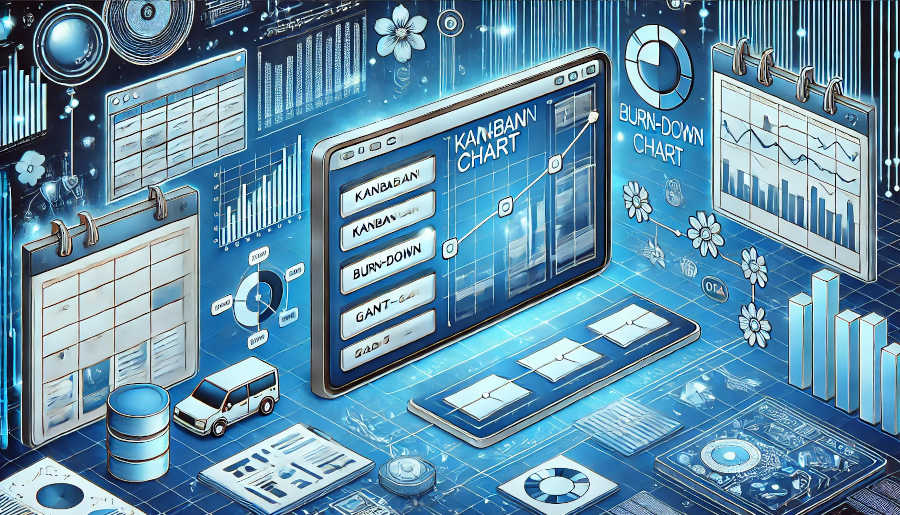Gantt charts are an essential tool in project management, serving as a visual representation of a project's schedule. They provide a clear overview of the project timeline, including start and end dates for each task, dependencies between tasks, and the overall project duration. This visual clarity helps project managers, team members, and stakeholders to understand the project plan at a glance, making it easier to identify potential issues and make informed decisions.
By using a Gantt chart, project managers can effectively allocate resources, set realistic deadlines, and track progress. The chart allows them to see which tasks are critical to the project's success and which ones can be delayed without affecting the overall timeline. It also helps in communicating the project plan to the team, ensuring that everyone is on the same page and aware of their responsibilities. Moreover, Gantt charts can be used to monitor project performance over time, comparing the actual progress against the planned schedule.
In addition, Gantt charts are valuable for risk management. They enable project managers to anticipate potential delays by identifying tasks with long durations or high dependencies. This early identification allows for proactive measures to be taken, such as reallocating resources, adjusting the schedule, or seeking additional support. Overall, Gantt charts play a crucial role in keeping projects on track and ensuring their successful completion.
Common Causes of Project Delays
Project delays can occur due to a variety of reasons, and understanding these causes is crucial for effective management. One common cause is inaccurate project planning. If the initial project plan does not account for all the necessary tasks, dependencies, or resource requirements, it is likely to lead to delays. For example, underestimating the time required for a complex task or overlooking the need for specialized equipment can throw off the entire schedule.
Another significant cause of delays is resource constraints. Insufficient resources, whether it's a lack of skilled personnel, limited budget, or unavailable materials, can slow down project progress. If team members are overloaded with work or if there are shortages of essential supplies, tasks will inevitably take longer to complete. Additionally, unforeseen events such as natural disasters, changes in regulations, or supplier issues can also disrupt the project schedule.
Poor communication is also a major contributor to project delays. When there is a lack of clear communication among team members, stakeholders, and project managers, misunderstandings can occur. This can lead to tasks being repeated, important information being overlooked, or decisions being delayed. For instance, if a team member is not aware of a change in project requirements, they may continue working on the wrong version, wasting time and causing delays.
Analyzing Delays Using Gantt Charts
Gantt charts can be a powerful tool for analyzing project delays. By comparing the actual progress of tasks against the planned schedule on the Gantt chart, project managers can quickly identify which tasks are behind schedule. The chart shows the start and end dates of each task, allowing for an easy visual comparison. If a task's actual end date is later than the planned end date, it indicates a delay.
Once the delayed tasks are identified, project managers can dig deeper to understand the root causes. The Gantt chart's dependency lines can provide valuable insights. If a task that is dependent on another delayed task is also behind schedule, it may be due to the upstream delay. On the other hand, if a task has its own independent delay, further investigation is needed to determine whether it's due to resource issues, unforeseen problems, or other factors.

Moreover, Gantt charts can help in assessing the impact of delays on the overall project timeline. By looking at the critical path of the project (the sequence of tasks that determines the shortest possible project duration), project managers can see if the delay has affected the project's end date. If a task on the critical path is delayed, it will likely push back the entire project completion date. This analysis enables project managers to prioritize their efforts in addressing the delays.
Strategies for Dealing with Project Delays
When faced with project delays, there are several strategies that project managers can employ. One approach is to reevaluate the project plan. This may involve breaking down tasks into smaller, more manageable subtasks, which can be completed more quickly. It could also mean adjusting the dependencies between tasks to find more efficient ways of working. For example, if two tasks were originally planned to be sequential but can be done in parallel with some coordination, this can save time.
Another strategy is to allocate additional resources. If a task is delayed due to a lack of resources, such as manpower or equipment, adding more resources can help speed up the process. This could involve hiring temporary staff, reallocating existing team members from less critical tasks, or investing in new tools or technologies. However, it's important to consider the cost and availability of these resources before making a decision.
Communication is also key in dealing with delays. Project managers should keep stakeholders informed about the delays, the reasons behind them, and the steps being taken to address them. This transparency helps to manage expectations and maintain trust. Additionally, improving communication within the team can prevent further delays. Regular meetings, clear instructions, and a shared project management tool can enhance communication and collaboration.
Preventing Future Project Delays
While dealing with current project delays is important, preventing future delays is even more crucial. One way to do this is by conducting a thorough project planning phase. This includes detailed task decomposition, accurate estimation of time and resources, and identification of all potential dependencies. By investing time in creating a comprehensive plan, the likelihood of unforeseen issues causing delays is reduced.
Another preventive measure is to build in contingency time. Allocating some extra time for each task or for the project as a whole can act as a buffer against unexpected delays. This contingency time can be used to address issues such as supplier delays, technical problems, or changes in requirements without derailing the entire project schedule. However, it's important to use this contingency time wisely and not rely on it as a substitute for proper planning.
Finally, continuous monitoring and evaluation of the project are essential. Regularly reviewing the project progress against the Gantt chart and making adjustments as needed can help catch potential delays early. By learning from past projects and implementing best practices, project managers can improve their ability to prevent delays and ensure the successful delivery of future projects.
In conclusion, Gantt charts are a vital tool in project management, especially when it comes to dealing with project delays. Understanding the importance of Gantt charts, identifying the common causes of delays, analyzing them using the charts, implementing effective strategies to address them, and taking preventive measures are all key steps in ensuring project success. By mastering these aspects, project managers can better navigate the challenges of project execution, keep projects on track, and deliver high-quality results within the specified time and budget. With proper use of Gantt charts and a proactive approach to delay management, projects are more likely to achieve their goals and meet the expectations of stakeholders. This not only benefits the individual project but also contributes to the overall success and reputation of the organization.
ARTICLE TITLE :Gantt chart making: how to deal with project delays ,AUTHOR :ITpmlib

















